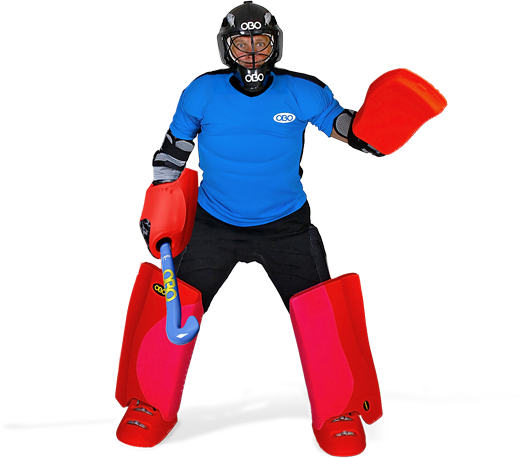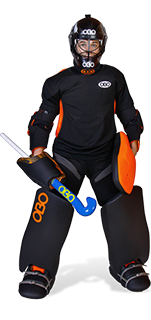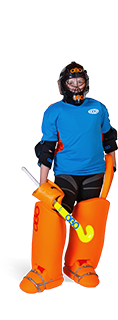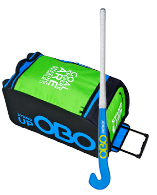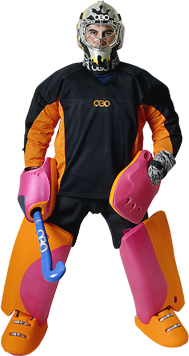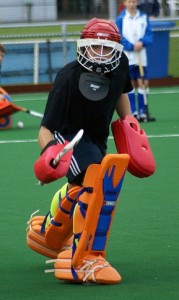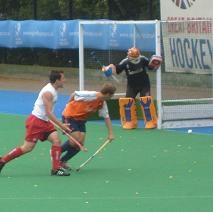KEEPERS RESOURCES

Focus on the ball!
When setting for the save, you need to be watching the ball. True eye contact allows you to focus on the ball and react accordingly to make the appropriate blocking action. Obviously this is not always possible in every situation, like tips and deflections where you see the ball at the last minute, but on point shots and at short corners, you should maintain a strong focus on the ball. By being pro-active and alert, you are in a better position to make the save; so whenever you make a save, or kick clear, you should always set your focus on the ball and maintain it throughout the save process, so as to maximise your efficiency.
Focusing on the ball
When watching the shot, you should focus on the ball from the ball carrier or shot all the way into the save. The way you watch the ball goes back to the fundamental skill of reading the game; not over committing and reacting to what happens in front of you. When the potential shooter becomes obvious, you can then focus on the ball’s positioning, setting up on the angle and in your stance ready to make the save. Watch the path of their hit or flick; watching the ball from the stick all the way into your equipment; putting a strong emphasis on focusing on the ball from release to reaction. Self discipline is the order of the day, with you needing to remind yourself every time to give 100% focus on the ball and the shot.
Watch the ball ALL the way in
In order to make a strong save with good execution, you need to be focused on the ball. If you react at the last second, you can’t expect to be in a good chance of stopping the ball! When some goalkeepers will close their eyes or flinch at shots (which is a problem we can all face, not helped by poor equipment), you instead need to be confident in your kit and confident in that you will be able to make the save unharmed.
When making any save, you want to be watching the ball ALL the way into your body – the specific piece of equipment making the save. In each case the basic principal remains the same: by focusing on the ball’s complete flight, you stand a better chance of making the save than if you only caught sight of it at the last minute. It terms of concentration and focus of elite goalkeepers, you can find photos of soccer goalies facing penalties where they are clearly following the path of the shot even if they have been beaten.
Remember, it’s fairly simply; the more you focus, the more chance you have of making the save, so do your best to give it a hundred per cent.
The ‘quiet eye’
Research and sports science studies has shown that the more a goalie focuses on the object coming at them (depending on the sport played!), the more they save. In ice hockey, the concept of the ‘quiet eye’ has been developed. It has been scientifically proven, that the more focus the goalie puts on the puck, the better chance they have of saving it. This link between eye contact and reaction is important to realising the need for total focus on the ball when goalkeeping in hockey.
The following clip is a good insight into the understanding:
http://www.youtube.com/watch?v=mPZCCpmRObw
‘Well watched’
Watching professional soccer (football), you will often see the goalkeepers raising their hands up against a shot that goes wide. This asserts that they have been paying attention and know the ball is not going to end up in the net! When Vogels was playing (he is obviously retired now), he used to put his hands up when the ball had gone off, to show to the umpire and team that the play was dead and the ball had gone off. Similarly, you can show that you are certain the ball is wide of the goal or going over (by knowing your angles), by raising your gloves. If you feel it helps, calling “Wide!” will also help your defence know you are leaving the shot. It takes a bit of experience and practise though!
Glove saves
The glove save sounds the most obvious form of save involving eye contact, with the goalkeeper watching the raised ball from shot to finished save, moving the glove into touch to block the incoming ball. However, you still need to be focused on the saving process and the ball, maintaining it throughout the saving motion in order to execute technique properly and help focus on the redirection for rebound control.
Stick saves
Stick saves are a little trickier due to the width of the stick and the reduced stopping surface that the stick offers. Nevertheless, it is important that you read the shot off the shooter’s stick and move the stick in to contact with the ball as required.
RHP
Using your RHP to block the shot, rather than relying on the stick (if ), gives you a better chance of making saves to your right given the larger surface area the new styles of right hand protectors provide. Turning at the wrist and pushing into the save, your focus remains the same: making prolonged eye contact with the ball into contact with your rhp.
Pad saves
The pad save may not seem like an area needing a write up on, but eye contact with the incoming ball will allow you to concentrate on the initial save along with the following rebound. As the shot comes in you will obviously be lowering your view to the ground, following the shot low into your pad.
Kicker stops
In order to make a well executed stop with your kicker, you need to watch the ball into your foot; looking down to the pitch, to focus on being able to react appropriately, just like a pad save. When kicking clear, or making the save, the focus is the same: watching the connection with the foot to make sure the angle is correct and the clearance is sufficient. For the ball to be effectively cleared on the play, you need to be paying attention to the angle of the incoming ball and then set up the redirect to match.
Chest/body
Though it’s not always orthodox or best (though I have seen it being taught by Dutch coaches and is good for blocking against deflections and killing rebounds), body saves still need your focus (and trust in your kit!). If you are forced into blocking the ball, you need to be aware of where the rebound goes in order to respond with your repositioning or clearance, forcing you to make eye contact with the ball.
Diving
When diving, the concept remains the same, and watching the ball all the way into the save betters your chances of making the save, as well as getting a look at the incoming ball, for a well placed redirect to steer the ball to safety. Diving into the save puts the focus on the stick and rhp or glove; changing your focus to a lowered state to watch the ball into the save.
Jumping saves
When jumping, or high diving to reach the ball, your focus translates to the ball’s position, with your eyes ready watching the distance between you and its destination, so you are set to make the save with your equipment as you get closer to the ball through the jumping motion. With the ball away from you from the beginning, you need to watch with great awareness; judging the distance of the ball as you move in to block it.
Blocked view
Sometimes you will be faced with situations where your view is impinged and you may struggle to see the ball. Here, the need is to locate the ball holder and react to the situation as it develops. This obviously makes life difficult. Whilst you may not get the chance to be totally focused, you can still prioritise your focus to react on the instant you catch sight of it, making sure you made the effort to focus on the incoming shot.
Pointers:
- Give a 100% in your efforts; focusing on the shot ALL the way in
- Use training and warm ups as a chance to focus on each shot in this way to reinforce good habits for game time
- Try not to block your view of the ball unnecessarily during the save process; using your gloves independently when bringing the glove across to the right could block your vision
On short corners
Short corners are a time when you see goalkeepers losing their focus on the ball, even at the elite level. Instead of watching the ball from the injection to the flick or shooter, they simply choose to react to the corner as the play unfolds. However, I feel that short corners are an important time for goalkeepers to be focused on the ball because of the score rate of corners. Focusing on the ball at the injection right through to the drag flick or shot will help provide you with a good focus for making the eventual save, as well as helping you to track the ball to the shooter (if there are multiple ‘castles’ or dummies) or slip pass for a routinely planned redirect.
At flicks
Penalty flicks are another time when it is important to have good focus on the ball. Players can easily wrong foot you and send you the wrong way with a dummy or using their eyes to pretend to be going one way (and go the other!) as you play against better quality opposition. Instead, make sure you focus on the ball and nothing else; going the right way as it comes at you in order to stand the best chance of making the save.
Focus, focus, focus!
Ultimately, the most important thing to remember is the need for focus when faced with making the save. The more you focus, the more likely you are to stop everything! In training and practise try and set your targets on focusing on every shot without fail; the more you force yourself to focus totally on the ball for the shot, the better goalkeeper you will be.
Comments
Leave Your Comments Below















